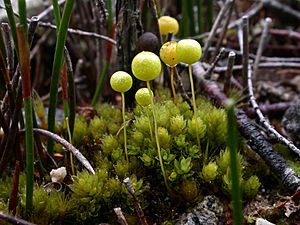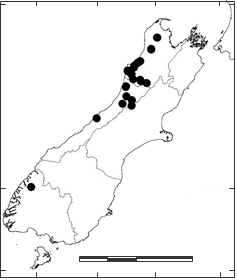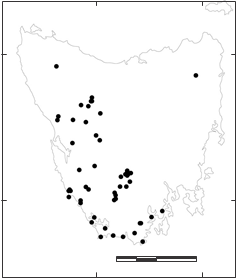Pleurophascum grandiglobum facts for kids
Quick facts for kids Pleurophascum grandiglobum |
|
|---|---|
 |
|
| P. grandiblogum, growing on the subalpine buttongrass moorlands along Gelignite creek, Scotts Peak Dam Road | |
| Scientific classification | |
| Genus: |
Pleurophascum
|
| Species: |
grandiglobum
|
Pleurophascum grandiglobum is a special type of moss that only grows in Tasmania, Australia. A scientist named S. O. Lindberg first described it in 1875. He was very excited about its large, colorful seed pods (called capsules). These capsules are unique because they don't open with a lid like many other mosses.
This moss belongs to a small family called Pleurophascaceae. This family has only one genus, Pleurophascum, and it includes three different species. You can find these mosses in temperate parts of Australasia.
- Pleurophascum ovalifolium* is found in New Zealand. It used to be considered a variety of P. grandiglobum.
- The third species, Pleurophascum occidentale, grows only in Western Australia.
For over 50 years, scientists were puzzled about the link between P. grandiglobum and P. ovalifolium. It wasn't until around 2005 that the New Zealand moss was recognized as its own species. P. ovalifolium has leaves with straight edges and bright orange-red capsules. These capsules become flat and disc-shaped when they are fully grown. In contrast, P. grandiglobum has leaf edges that curl back and orange-green capsules.
P. occidentale is quite different from its two cousins. It grows along the coast in southwest Western Australia. Its reproductive parts grow at the end of its stems, not on the sides. Also, its capsules do not have stomata (tiny pores) at their base. These differences suggest that P. occidentale has been separated from the other two species for a very long time.
The name Pleurophascum comes from Greek words. Pleuron means "lateral" (side), and phascon refers to a type of plant. Together, they describe how the capsules of P. grandiglobum grow from short branches on the side of the plant.
Contents
What is Pleurophascum?
When P. grandiglobum was first found in 1875, scientists thought it was the only species in the Pleurophascum group. For about 75 years, it was believed that this moss only grew in Tasmania.
Today, we know there are three species:
- Pleurophascum grandiglobum and Pleurophascum occidentale are found only in Australia.
- Pleurophascum ovalifolium is found only on the South Island of New Zealand.
Scientists have debated where to place Pleurophascum in the moss family tree. In 1924, Brotherus put it in its own special group because of its unique leaves and how its reproductive parts and capsules are formed. In 1984, Vitt suggested it belonged to its own family, Pleurophascaceae. Later, in 2000, other studies suggested it might be related to other moss families. The exact place of Pleurophascum in the moss world is still a mystery! Scientists hope that new studies using DNA and how plants grow will help solve this puzzle.
How P. grandiglobum Looks
P. grandiglobum is a medium-sized moss. It can grow up to about 10 millimeters (0.4 inches) tall. It often grows alone or in small groups. The top part of the moss is bright yellow-green, and the bottom part is dark brown.
Its main stem grows underground. Small side branches and pale, smooth root-like structures called rhizoids grow from these stems. The leaves are deeply curved and crowded at the top of the stems. This makes the plant look like it has a bushy top. The edges of the leaves are usually smooth or have a few small teeth.
The moss has special structures for reproduction. The female parts (perichaetia) are on short side branches. After fertilization, they swell up. The male parts (perigonia) are also on short side branches.
The most noticeable part of P. grandiglobum is its large, round capsule. This capsule is held up by a long stalk, about 18–25 millimeters (0.7–1 inch) long. The capsule itself is about 2.6–4.9 millimeters (0.1–0.2 inches) wide. At the top of the capsule, there's a small point. At the bottom, there are many tiny pores called stomata.
Capsules usually ripen from spring to late autumn. They change color from pale green to orange. When ready, they split open on the side to release smooth, oval spores. These spores are very tiny, about 35-57 micrometers wide. The moss grows in many different altitudes, which helps it have a long period for fruiting. Remember, P. grandiglobum capsules are always round and never turn bright orange-red and flat like those of P. ovalifolium.
Where P. grandiglobum Lives
You can find P. grandiglobum in the west, southwest, and central highlands of Tasmania. It also extends to the Neasey Plains in the northwest and down to Mt Esperance and Birch Inlet in the southeast.
This amazing moss loves wet or boggy soils. It grows in subalpine Tasmanian button-grass moorlands, which are open areas with a type of grass. These areas are often around 1400 meters (4600 feet) above sea level. In the southwest, it prefers peaty or gravelly soils. At higher places, it often grows in wet spots among other mosses and plants.
Even though it's found in many places in Tasmania, P. grandiglobum only grows on this island. This might mean its spores don't spread very far. Scientists have noticed that its capsules are often eaten or damaged before they are fully grown. It's rare to find mature capsules that last from one summer to the next. They think a wombat might be eating them, but they are still trying to figure out exactly what animal is doing it and how it affects the moss's ability to spread.
Characteristics of the Pleurophascaceae Family
Mosses in the Pleurophascaceae family often form loose, yellow-green or brown-green clumps. They have a main stem that creeps underground with pale, root-like structures. Their upright secondary stems have side branches.
The leaves are usually broadly oval and deeply curved. They are packed closely together at the top of the stems. The leaf edges can be upright or slightly curled back. They are usually smooth or have small teeth.
This family of mosses is dioecious, meaning male and female reproductive parts are on separate plants. These parts grow on short side branches from the secondary stems. However, in P. occidentale, they grow at the very end of the stems.
The capsules in this group are very large and do not have a lid. They can be round, disc-shaped, or egg-shaped, depending on the species. They are held up by a stalk that can be long or very short. The capsules have a blunt or rounded tip. Some species have stomata (pores) at the base of the capsule, while others do not. The calyptra (a cap that covers the capsule) is smooth and falls off quickly. It releases large, smooth spores.
Images for kids





